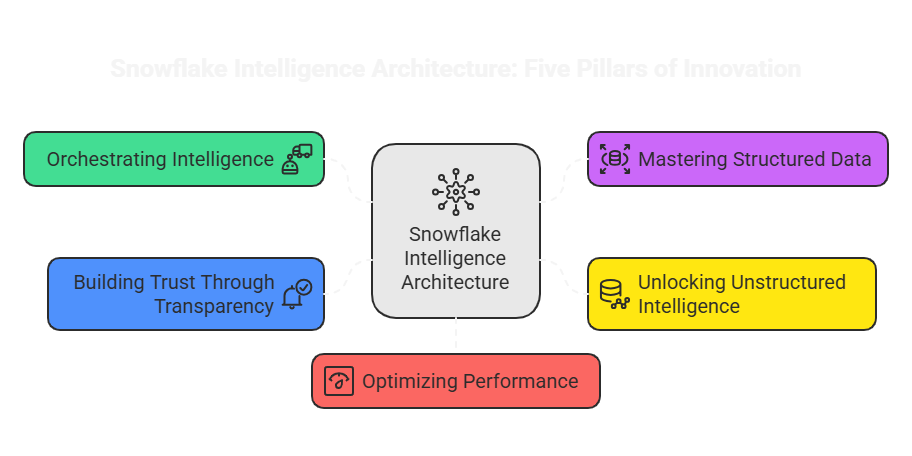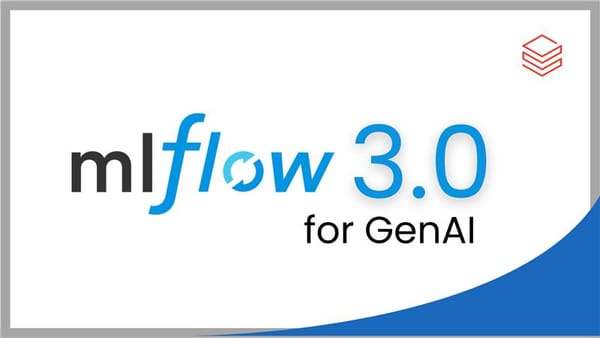Snowflake Intelligence: Turn Questions into Business Insights
Empowering systems to think, decide, and act with autonomy.

Introduction: The Dawn of Intelligent Data Platforms
Enterprise AI is undergoing a major transformation. Traditional approaches that rely on fragmented tools and disconnected data sources are giving way to unified, intelligent platforms. At the forefront of this transformation stands Snowflake Intelligence, a groundbreaking agentic AI system that promises to redefine how organizations approach data-driven decision making.
This comprehensive guide examines how Snowflake Intelligence is revolutionizing the landscape of enterprise AI, its core architectural principles, and its implications for businesses seeking to leverage the power of artificial intelligence at scale.

Understanding Agentic AI: Beyond Traditional Machine Learning
What Makes AI "Agentic"?
Agentic AI represents a fundamental departure from conventional machine learning models. While traditional AI systems respond to specific inputs with predetermined outputs, agentic systems demonstrate autonomous reasoning, planning, and decision-making capabilities. These systems can:
- Analyze complex scenarios and break them down into manageable components
- Make strategic decisions based on contextual understanding
- Adapt their approach dynamically as situations evolve
- Execute multi-step workflows without constant human intervention
To explore how agentic AI is also driving innovation through Microsoft’s MCP and A2A capabilities, check out our detailed blog
The Enterprise Challenge
Modern enterprises face a critical challenge: how to effectively leverage AI across diverse data types, business processes, and organizational structures. Building isolated point solutions often leads to:
- Data silos that prevent comprehensive analysis
- Integration complexity that slows deployment
- Governance gaps that create compliance risks
- Scalability limitations that hinder enterprise-wide adoption
Snowflake Intelligence Architecture: Five Pillars of Innovation
1. Orchestrating Intelligence: The Power of Agentic Coordination
The first pillar focuses on creating autonomous systems capable of complex task execution. This orchestration layer enables AI agents to:
Strategic Planning: Break down high-level business objectives into executable steps, considering dependencies, resource requirements, and potential obstacles.
Dynamic Tool Selection: Choose the most appropriate tools and techniques for each subtask, optimizing for accuracy, speed, and resource efficiency.
Adaptive Execution: Monitor progress and adjust strategies in real-time based on intermediate results and changing conditions.
Cross-Domain Integration: Seamlessly work across different data types, business functions, and analytical frameworks.
2. Mastering Structured Data: Natural Language Intelligence
The second pillar transforms how organizations interact with their structured data assets. Key capabilities include:
Semantic Understanding: Interpreting business terminology and context to generate accurate queries that reflect actual business intent.
Schema Intelligence: Automatically navigating complex database structures, understanding relationships, and optimizing query performance.
Business Logic Integration: Incorporating domain-specific rules, calculations, and constraints into automated analysis workflows.
Scalable Analytics: Supporting everything from simple lookups to complex multi-table analytical operations across massive datasets.
3. Unlocking Unstructured Intelligence: Context-Aware Analysis
The third pillar addresses one of enterprise AI's biggest challenges: making sense of unstructured data. This includes:
Document Intelligence: Extracting meaningful insights from contracts, reports, emails, and other text-heavy documents while maintaining accuracy and context.
Knowledge Grounding: Connecting unstructured insights to structured data sources to provide comprehensive, evidence-based analysis.
Content Synthesis: Combining information from multiple unstructured sources to create coherent, actionable intelligence.
Domain Specialization: Adapting analysis techniques to specific industries, use cases, and organizational contexts.
4. Building Trust Through Transparency: Observability and Governance
The fourth pillar addresses enterprise requirements for accountability and compliance:
Decision Traceability: Providing clear audit trails that show how conclusions were reached, what data was used, and which analytical steps were taken.
Performance Monitoring: Continuously tracking system performance, accuracy, and reliability across different use cases and data types.
Bias Detection: Identifying and mitigating potential sources of bias in automated decision-making processes.
Compliance Integration: Ensuring all AI operations align with regulatory requirements and organizational policies.
5. Optimizing Performance: Advanced Inference Systems
The fifth pillar focuses on the technical infrastructure required for enterprise-scale AI:
Computational Efficiency: Optimizing processing workflows to minimize latency and maximize throughput while controlling costs.
Memory Management: Handling large datasets and complex models efficiently, even when working with limited computational resources.
Parallel Processing: Distributing workloads across multiple systems to enable real-time analysis of massive datasets.
Intelligent Caching: Speeds up operations by storing frequently used data and intermediate results

Real-World Applications: Transforming Business Operations
Financial Services: Intelligent Risk Management
Financial institutions are leveraging agentic AI systems to revolutionize risk assessment and regulatory compliance. These systems can:
- Analyze market data, regulatory filings, and news sources simultaneously
- Generate comprehensive risk reports that combine quantitative metrics with qualitative assessments
- Monitor compliance across multiple regulatory frameworks in real-time
- Provide early warning systems for emerging market risks
Healthcare: Accelerating Medical Research
Healthcare organizations are using intelligent data systems to advance medical research and improve patient outcomes:
- Integrating clinical trial data with real-world evidence from electronic health records
- Identifying potential drug interactions and adverse events across large patient populations
- Supporting personalized treatment recommendations based on comprehensive patient profiles
- Streamlining regulatory submission processes through intelligent document analysis
Manufacturing: Optimizing Operations
Manufacturing companies are deploying agentic systems to enhance operational efficiency:
- Predicting equipment failures by analyzing sensor data, maintenance records, and environmental conditions
- Optimizing supply chain operations through intelligent demand forecasting and inventory management
- Improving quality control by integrating inspection data with production parameters
- Reducing energy consumption through intelligent facility management systems
Implementation Strategy: Getting Started with Intelligent AI
Assessment and Planning
Current State Analysis: Evaluate existing data infrastructure, AI capabilities, and business requirements to identify opportunities for intelligent system deployment.
Use Case Prioritization: Select initial applications that offer clear business value while building organizational confidence in agentic AI capabilities.
Resource Planning: Ensure adequate technical infrastructure, skilled personnel, and organizational support for successful implementation.
Deployment Approach
Pilot Programs: Start with controlled environments that allow for experimentation and learning without significant business risk.
Iterative Development: Build capabilities incrementally, incorporating feedback and lessons learned at each stage.
Change Management: Prepare organizations for new ways of working with AI systems that demonstrate greater autonomy and intelligence.
Success Metrics
Business Impact: Measure improvements in decision speed, accuracy, and business outcomes directly attributable to intelligent AI systems.
Operational Efficiency: Track reductions in manual effort, faster time-to-insight, and improved resource utilization.
User Adoption: Monitor how effectively business users engage with and trust AI-powered tools and recommendations.
The Future of Enterprise AI: What Lies Ahead
Emerging Trends
The evolution toward more intelligent, autonomous AI systems is accelerating. Key trends include:
Multi-Modal Intelligence: Systems that seamlessly integrate text, images, audio, and structured data for comprehensive analysis.
Collaborative AI: Agents that work together on complex tasks, sharing knowledge and coordinating activities across organizational boundaries.
Adaptive Learning: Systems that continuously improve their performance based on feedback and changing business conditions.
Democratized AI: Tools that enable business users to create and deploy sophisticated AI applications without extensive technical expertise.
Strategic Implications
Organizations that successfully adopt agentic AI systems will gain significant competitive advantages:
- Faster Decision Making: Real-time analysis and recommendations that enable rapid response to market changes
- Improved Accuracy: Reduced human error and bias in critical business processes
- Enhanced Innovation: AI systems that identify new opportunities and generate creative solutions
- Operational Excellence: Streamlined processes that maximize efficiency while maintaining quality
Conclusion: Embracing the Intelligent Future
Snowflake Intelligence represents a pivotal moment in the evolution of enterprise AI. By combining agentic orchestration, comprehensive data intelligence, robust governance, and optimized performance, it offers a blueprint for the future of intelligent business systems.
Organizations that embrace this new paradigm will be better positioned to navigate an increasingly complex and dynamic business environment. The key is to start with clear objectives, build capabilities incrementally, and maintain focus on delivering tangible business value.
The future belongs to organizations that can effectively harness the power of intelligent, autonomous AI systems. Snowflake Intelligence provides the foundation for this transformation, offering a comprehensive platform for building the next generation of data-driven applications.
As we move forward, the question isn't whether agentic AI will transform enterprise operations—it's how quickly organizations can adapt to leverage these powerful new capabilities. The time to begin this journey is now.

FAQs
1. What is Snowflake Intelligence, and how is it different from traditional AI tools?
Answer: Snowflake Intelligence unifies structured and unstructured data through an advanced agentic AI framework. Unlike traditional tools, it enables autonomous decision-making, dynamic tool selection, and end-to-end workflow execution, offering intelligent, scalable insights without constant human input.
2. What does "agentic AI" mean, and why is it important for modern enterprises?
Answer: Agentic AI is smart technology that can think, make decisions, and do tasks on its own—just like a helpful assistant.. It’s critical for enterprises because it allows AI to adapt, make decisions, and execute workflows independently, improving speed, efficiency, and business agility.
3. How can Snowflake Intelligence handle both structured and unstructured data?
Answer: It combines schema intelligence for structured data with advanced language models for unstructured sources. This allows it to extract, connect, and analyze insights across databases, documents, and real-world text with contextual accuracy.
4. What are the key benefits of implementing agentic AI in my organization?
Answer: Benefits include faster decisions, reduced manual effort, better compliance, deeper insights, and improved scalability. Agentic AI helps organizations act on real-time intelligence, not just raw data.
5. How do we get started with Snowflake Intelligence in our enterprise?
Answer: Begin with a data and AI readiness assessment. Prioritize high-impact use cases, launch pilot projects, and scale iteratively. Ensure proper infrastructure, training, and clear KPIs for measuring business value.




